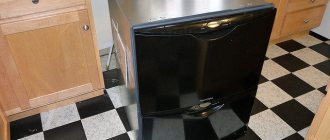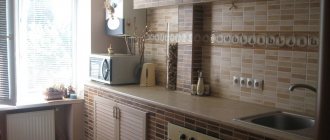The rule is widely known: the sink should be located away from the stove. This position has become a dogma. When someone on forums and social networks asks to evaluate a kitchen project, the distance between the sink and the stove is almost the first thing they pay attention to. The close proximity of these elements is unconditionally declared a disadvantage. Furniture makers also try to dissuade clients from such a layout if the size of the kitchen allows for the distance between the corners of the working triangle. “You can’t have a stove and a sink next to each other,” is the verdict. Not everyone can justify the ban. You can't, period. However, many refer to the principles of ergonomics.
Yes, they exist. The most convenient and safest is a working triangle, the sides of which are 60-120 cm .
But is this rule of ergonomics really true? Is it relevant in modern conditions? These questions are best addressed to those who have experienced the “wrong” layout from their own experience. Theory is theory, but in practice everything is far from being as clear as stated in the instructions and rules.
I had to manage kitchens with different locations of the main elements. There was also a classic version with a gap of 90 cm. There was also a corner solution: the stove and sink were on opposite sides of a right angle. In the end, I became the owner of an apartment where fire and water are as close to each other as possible. This is what the architect decided (because there are no official rules or requirements for this!).
I cooked in a basic kitchen layout for a while, and then it was time to order and install new cabinetry and appliances. My kitchen is relatively large (16 sq. m). It is possible to space the corners of the working triangle on different sides, but I did not do this. Why? Because I realized that close proximity to the sink and stove is convenient. At least for me.
What is convenience? What pros and cons can I name? How to avoid possible problems? I will share my vision based on personal experience.
Argument No. 2. Safety precautions
If you carefully read the instructions supplied with the kitchen stove, you will not always find instructions there on what minimum distance it should be from other appliances, furniture and the sink.
“Keep the minimum permissible distances from other appliances and furniture,” reads the instructions for the electric stove. But it is very difficult to find official regulations on this issue. Maybe they don't exist at all? In any case, no matter what kind of stove is installed in your kitchen - electric or gas, precautions are necessary in both options. Having electricity and water nearby is an unacceptable concept in itself
Although the electrical insulation of modern slabs and proper connection by a professional technician will ensure your complete safety. But if the installation was done by a non-professional, then he could easily violate the mandatory standards related to grounding, the location of sockets, or the presence of circuit breakers on the panel. In this case, there is a chance of a short circuit and its consequences.
With a gas stove, the close proximity of the tap to it can play a cruel joke - the flame will be flooded with water in the most unexpected way. At the same time, the gas will continue to flow, and if you don’t notice what happened in time... It’s not far from an explosion.
Planning the lower and upper tiers of the linear set
The bottom modules are where you should start planning. In this case, you need to take into account all the equipment that will stand alone or be built in. The space that will remain free is for cabinets.
A built-in oven and hob are the classic equipment of the lower tier.
A pencil case is useful, as such cabinets are very spacious. They can accommodate a dishwasher, refrigerator, oven. Therefore, if the size of the niche allows you to make it smaller, it is better to install one or two pencil cases in the corner.
The pencil case is a large cabinet on the right side of the kitchen.
What modules the top tier will contain is completely determined by your desires:
- if you don’t like to deviate from time-tested options, choose standard narrow wall-mounted modules for the upper tier;
- lovers of minimalism will like a straight set without upper cabinets or replacing them with shelves;
- For those who love maximalism, straight kitchens in three rows up to the ceiling are suitable.
Sink installation work - sequence of work
At the first stage, the location of the sink is determined. Regardless of whether you plan to install a large sink or a small one, stainless steel or artificial stone, mortise or overhead, it should be mounted as close as possible to the place where the old structure stood. This will save you from having to make long communication paths.
If such work is still necessary, then the easiest way is to assemble a new water supply system from plastic pipes. To make the structure reliable, use rubber seals and special fum tape during work.
Plastic pipes are easily connected to old threaded connections.
Advice! If there is a need to lay communications along the kitchen wall, then hide the pipes behind a decorative box.
Assembling and installing kitchen plumbing with your own hands is not difficult. Installing a corner sink is essentially no different from installing a regular sink.
- Use a corrugated hose to drain water from the new sink into the old sewer pipe. First, it is supplied to the sink drain, and then discharged through a hole in the back wall of the cabinet and connected to the sewer pipe. A rubber seal must be used at the junction to allow the pipes to fit tightly against each other.
- The hose under the sink is connected to a siphon - this will prevent the pipes from becoming clogged with debris.
- After installing the water supply, the installation of the sink begins. Theoretically, it can be attached to the wall with brackets, but this hanging method is more suitable for the bathroom. Most often, a stainless steel (ceramic, stone) sink is installed on a cabinet or countertop that serves as its base. If a mortise design is used, then you cannot do without appropriate furniture with a durable tabletop.
- The cabinet with the installed sink must be fixed to the floor or walls.
- The installation of plumbing begins with the installation of a mixer. It can vary in design and be attached to different bases. Such a “support” can be either a wall or a sink (stainless or made of artificial stone). The mixer on the wall is mounted strictly horizontally, level. To adjust its position, use the included eccentrics.
- Upon completion of all work, you need to check the water supply and sewer connections - if you were able to assemble everything correctly, then no leaks will occur with the faucets open.
- Installing a kitchen sink - instructions, tips, videos
- Choosing a kitchen sink in 5 simple steps
- All about kitchen sink sizes
- How to choose a kitchen faucet
- Features of self-assembly of a kitchen corner set
- DIY kitchen faucet repair
- Kitchen sink made of artificial stone - 8 tips for choosing
Subtleties of transferring the sink
When remodeling a kitchen, it is also necessary to take into account all the subtleties of moving the water intake point. Extension of the sewer pipeline requires the greatest attention. According to the installation rules, the drainage system should be located on a slope. This condition must be observed to avoid blockages. When installing, the drain pipe should be raised 3-5 cm above the floor level for each linear meter of transfer.
Attention! Think in advance about the options for installing a water supply and drainage system; problems with their operation can freeze the functionality of the entire kitchen for a long time.
With the ergonomics of the kitchen space, everything is more or less clear:
- if the lady is right-handed, then a comfortable arrangement in a linear kitchen is from left to right: refrigerator, sink, hob, and there should be a working plane between all objects. That is, I took the food out of the refrigerator, put it on the countertop, washed it, put it on the cutting board, cut it, and put it in the frying pan. In this case, a minimum of unnecessary movements, a maximum of useful output;
- if the housewife is left-handed, everything is the same, only from right to left: refrigerator, sink, stove.
We figured out the convenience of the location of the equipment. It's time to get to the most frequently asked question:
It is important to consider:
- The sink should not be placed close to the refrigerator or stove. The recommended distance is at least one standard work surface, that is, 60 cm. If there is very little space, then it is better to place the sink closer to the refrigerator than to the stove.
- It is also better not to place the sink close to the side wall, so the wall will not be exposed to unnecessary moisture, and it will be much more convenient to wash large dishes. If the wall is the most convenient place in your case, then it is better to buy a sink with a wing and mount it to the wall or a round one and turn it slightly towards the center of the kitchen.
- When planning the location of the sink, take into account the communications: the farther the sink is from the pipe exit, the more expensive the installation and the higher the risk of leaks.
Now - about the best places for washing in the kitchen.
Kitchen ergonomics: how to plan an interior project
Ergonomic kitchen – convenient and comfortable. Even in a small area the room is not cluttered
Regardless of the size of the kitchen area, before starting renovations, you need to draw a plan for the future kitchen on a piece of paper. Accurately mark the arrangement of everything that you want to place in this space. But don’t forget about the rules for arranging furniture, the observance of which will help you comfortably spend time preparing food.
The main rules for arranging furniture:
- The tabletop is the work area where the housewife spends the maximum amount of time, so this equipment is installed depending on her height. The most common height is 85 cm, but if tall owners find it uncomfortable, there is an option with a table top height of 90 – 100 cm. Determining the appropriate height is not difficult. To do this, bend the arm at the elbow 90°C parallel to the floor and measure 15 cm down.
- The dining table is chosen lower than the tabletop. The most common table height is 70 – 80 cm.
- Gas stove. For safety reasons, it is installed at least 50 cm from open balcony doors or windows, where the air flow can blow out the flames of the fire.
- The hood is also installed depending on the height of the owners. The most common option is 60 - 70 cm in height from the stove. Taller people set it 10–15 cm higher. But with this type of installation, the rule is that the higher the hood, the more powerful it should be.
- The kitchen sink should be deep and the mixer high, this will allow you to place larger pots in it. The dimensions of the corner sink can be selected depending on the workspace of the countertop. Do not forget that the sewer riser should be located no more than 2.5 meters from the sink.
- The dishwasher fits best near the sink, which will make it easier to connect to the utilities.
- The most suitable place for a refrigerator is a corner, and to make it more convenient to use it without taking up extra space, you need to rehang the door so that it opens towards the nearest wall (modern refrigerator models have such a function as reversing the doors).
How to plan a kitchen correctly in our video:
Is it possible to place the stove next to the sink?
Share on social media networks:
When planning the placement of household appliances, plumbing fixtures and functional furniture in the kitchen, it is very important to adhere to the canons of ergonomics and technical indicators. But it is equally important to place all the modules so that it is convenient for the housewife to use them, since she is the one who has to spend most of her free time in the kitchen
That is why today we decided to look into the question of whether it is possible to place a stove next to the sink, because this is the first thing that many people pay attention to when designing a kitchen space. Today we will introduce you to the basic principles of comfortable kitchen design and tell you what the minimum distance is possible between the hob and the sink to make it convenient and safe.
One and a half models
For practical housewives, a one-and-a-half sink is a very convenient option. This model has two bowls of different sizes.
This arrangement is convenient for simultaneously washing dishes and, for example, defrosting food. The containers are located very compactly, which is important for studio apartments.
Dimensions
The minimum size of a kitchen sink depends on the preferences of the owners. However, the maximum dimensions cannot in any way exceed the cabinet. Therefore, to determine the size, 2 measurements are taken. First, the width of the cabinet is determined, then the length of the fragment or the entire tabletop. A second measurement will be required if you plan to take a bowl with a wing/wings.
The kitchen sink is selected in accordance with the recommendations:
- The sides of the product do not touch the wall; 3-5 cm are left in reserve. If the dimensions of the cabinet are 50cm, then the sink is 45cm.
- The front sides of the bowl do not extend outward; they end 3-5 cm from the edge of the tabletop. Then the water does not splash out.
- A tight fit of the bowl is allowed only at the apron. Even then, experts do not recommend installing them closely.
- The overhead sink matches the dimensions of the cabinet.
Kitchens with a prism sink (bowl combined with a cabinet or cabinet) are large. The standard product size is 870×870. Those. 1 deals with the bowl. Although in this case the table is made together with the table top. Then the sink is suitable for medium-sized apartments.
The other side of the dimensions is the depth of the sink. 16-19 cm is considered ideal, water does not splash. When the depth is less, it is inconvenient to work. Therefore, the bowl is suitable for the bathroom. Select a depth of 20 cm or more if you bake a lot - this makes it more convenient to wash the baking sheets.
The deep version of the sink is very convenient for housewives
Sink shape and dimensions
Size and shape are concepts close in meaning. The capacity of the sink depends on the first, and the ease of use depends on the second. The following types are found:
- Square. Standard sizes: 50×50, 60×60, but there are others. Comfortable sinks, spacious, familiar to housewives. They are presented on the market in a variety of designs, materials of production, and functionality. Suitable for small kitchens;
- Rectangular. Standard sizes: 50×125, 50×100, 50×80, 55×50. The matching stainless steel kitchen tables are narrow but wide. Suitable for non-standard rooms and small kitchens. They come with two or more bowls;
- Round. Standard diameters: 45-51cm. Convenient to use, easy maintenance. Suitable for different sizes of kitchens. Disadvantage: lack of sections for accessories or drying dishes;
- Angular. Ideal for rooms where useful space needs to be saved;
- Pentagonal. Modern sinks are functional and practical. The dimensions of the kitchen table when using these bowls are large, so they are suitable for large rooms.
Shape is the only parameter of sinks that is selected based on your preferences, because... it does not affect performance characteristics.
Additional recommendations
There are tips to follow to ensure that your sink is functional and comfortable to use:
The dimensions of kitchen sinks are not selected based on the dimensions of the room or other parameters; you need to take into account the family’s habits. When people eat in a restaurant or cafe more often, a small sink is suitable
Don't buy a big sink if you have a dishwasher. Dishwasher - direct refusal of a large size sink
Kitchen faucet for a round sink - any, the load on it is not increased. And for corner ones and with several bowls, select a high-quality mixer. Otherwise it will soon fail. The sink cabinet is low. Do not forget about the countertop or sides of the sink, in the case of an overhead bowl. The sink is deep enough to wash baking trays, pots and pans. They cannot be cleaned in the dishwasher. Standard dimensions of a cabinet or cabinet: 35-60cm. First they buy it, then they select the sink.
The wings additionally protect the countertop; if available, you should buy a sink with them.
Advantages and disadvantages of a corner sink cabinet
By deciding on a corner sink and cabinet, you get several advantages:
- Significant space savings: with proper installation, you can use literally every centimeter rationally. At the same time, you will not lose in design: the appearance of such a design can be stylish and original. You will not lose out on the ease of use of the design.
- High degree of functionality. Due to its ergonomics, in such a cabinet you can easily place all the things you need in your household.
- Increased practicality and high level of comfort. This is especially true for L-shaped models. In this case, you can easily find all the necessary items, since the visibility range will increase. This is achieved due to the fact that the inside of the drawer is better visible when the door is opened. If you choose a trapezoidal model, then it will ideally accommodate rotating “cars”. In this case, if you pull the handle, several boxes will “come out” to you at once.
- Availability of modern storage systems that allow for the most convenient arrangement of equipment, household chemicals, etc.
Small modern kitchen with glossy facades
Country style kitchen with corner sink and cabinet
This corner cabinet fits perfectly with a round sink.
Bright L-shaped kitchen with a corner cabinet under the sink
Having considered the advantages of corner structures, one cannot help but note their disadvantages. Among which it should be highlighted that a narrow corner cabinet can only accommodate a small trash container. This is inconvenient for a large family. In addition, such structures are considered less reliable than straight cabinets. Such models are more susceptible to breakage. Another disadvantage is the higher price.
Knowing all the pros and cons of corner structures, you can make the right choice.
Minimalistic white kitchen with a bright glass splashback and corner sink
Freestanding kitchen corner with sloping corner cabinet under the sink
Contrasting light kitchen with a black countertop and a corner cabinet under the sink
Modern kitchen in gray tones
Grey colour
in kitchen design
The color gray has a very interesting history. Just three or four years ago he was considered sad and boring. Undeserved, isn't it? But today this color is at the peak of its popularity! And I really like it. Thanks to gray, the interior of an apartment can become more serious and even a little strict. It makes any color more noble and sophisticated.
There are gray kitchens here!
Kitchen living room
Combining a cooking space with a living room is a popular option in a modern home. This is a spacious room that allows you to arrange a kitchen and a guest area in one room. You can separate the food preparation area from the guest area with a bar counter or a narrow shelving unit. Arranged in this way will make it possible to zone the space.
From the part where the owners plan to receive guests, you should install a large, cozy sofa, and place a massive coffee table near it, at which you can eat. Hang a large plasma on the wall. In this part, fresh outdoor flowers, shelves with decor, wall decorations, and vases are appropriate. The combination of window and sofa textiles looks very stylish. These elements unify the living room area.
A small work area is furnished in a minimalist style with a light kitchen set and the necessary set of equipment. This area is highlighted by additional lighting, when you can hang a chandelier in the living room, place spotlights around the perimeter of the suspended ceiling, and so on. Place a floor lamp or hang a wall sconce near the sofa. Examples of how a kitchen can be decorated can be seen in the photo.
Modern style
in the kitchen interior
I really love kitchens built into niches!
They look stylish and thorough! Well, we have sorted out the functionality and ergonomics of this room, it’s time to move on to discussing the interior design. Kitchens in a modern style predominantly use perfectly smooth facades. Nowadays painted MDF facades are very popular. There are both glossy and matte and matte. Plastic facades are considered more affordable. They are inexpensive, but look like MDF facades.
Kitchens in this style do not have handles. The doors open by pressing. These models have push-up fittings. In particular, fronts with integrated handles are used; they have a small recess in the front.
Lots of modern kitchens!
Installing the stove
The stove in direct kitchens can be:
- built-in – makes the set more neat in appearance, while the hob is installed separately from the oven;
- freestanding is a classic that can stand out from the general look.
When you create a plan, remember the location of the pipes, the gas water heater, if there is one, and the hood.
Direct kitchens, in which the hob and oven do not depend on each other in planning, are much more convenient. If your goal is to save useful space on the countertop, then installing a small stove designed for two/three columns will help save about 30 cm.
A small hob with two sections.
The oven is often moved into a pencil case - this creates more space for dishes under the hob.
The oven is placed in the pencil case.
If cooking is not your thing, and you do it quite infrequently, then you don’t have to install a stove at all. Just buy a portable induction one and place it on your countertop when needed. It won't require a lot of storage space in the closet.
Near the window
Many housewives dream of washing by the window. It really looks impressive, plus there is a lot of natural light and a pleasant view of the street. Extending the tabletop along the window will provide additional work surface and storage space. However, there are also disadvantages: you will almost always have to extend communications far away, which will increase the cost of installation, and the windows will have to be frequently wiped clean from drops if a protective edge is not provided. It’s easier to implement such an idea at a dacha or in a country house, and the view of the garden is guaranteed to be more pleasant.
Small corner kitchens interior design
When choosing the design of an L-shaped kitchen, you should first of all take into account its size. A lot depends on him. The most common style for small rooms is modern
It allows you to combine different materials and textures, colors and shades. It is with the help of modernism that you can visually enlarge the space, for example, using glass and mirrors, or color accents that will help zone it
The most common style for small rooms is considered modern. It allows you to combine different materials and textures, colors and shades. It is with the help of modernism that you can visually enlarge the space, for example, using glass and mirrors, or color accents that will help zone it.
It is better to decide on the dimensions of the corner module at the very beginning, at the stage of designing the headset.
Objects made from materials with a voluminous pattern or texture are considered undesirable for small kitchens. They should not “put pressure” on the space, but, on the contrary, make it freer.
Whatever the style of a small corner kitchen, the main thing is that there are no frills. After all, they are the ones who can turn a stylish and atmospheric room into a cluttered room.
Built-in option
A built-in refrigerator will help save space in the kitchen; it will also harmonize with all the furniture, which will visually enlarge the space and relieve the feeling of congestion. In addition, the interior becomes neater.
In addition, the built-in model is much easier to care for; you just need to wipe the front and interior parts.
Whereas a different arrangement requires care of the surfaces of the refrigerator from all sides, in some cases from three sides, from above and inside.
What you can do and what skills you need
Are you striving for the perfect kitchen design? Then all the threads are in your hands. All that is needed is a creative vision, specialized knowledge and a desire for change! Today it's simple. But in the 19th century, when the idea of changing the kitchen space first came to the sisters Katharina Beecher and Hariette Beecher Stowe, author of the book “Uncle Tom's Cabin,” it was more difficult to reformat consciousness. In those days, women walked for miles, running around the kitchen from the sink to the stove and not having a second to rest and relax. But in 1869, when The American Woman's Home was first published, everything changed.
Washing according to Feng Shui is a combination of harmony, comfort and impeccability.
We follow the 5 basic rules of Feng Shui for a harmonious location of the sink in the kitchen
| 1 | We place the car wash in the northern, eastern or southwestern sector. The north corresponds to the element of water, the east and southwest correspond to the tree, to which it gives vitality. |
| 2 | We monitor the serviceability of taps and pipes. Water leakage provokes not only the appearance of dampness and mold, but also the outflow of positive energies. |
| 3 | We make sure that the sharp corners of the sink, if any, are not directed at the people sitting at the table. Thus, we increase the overall level of psychological comfort in the kitchen. |
| 4 | We separate the stove and sink areas. They represent opposite elements and should not touch. |
| 5 | We give preference to metal or stone, they are ideally combined with the water element. |
Neoclassical style
and kitchen design
Neoclassical kitchens are no different in functionality from modern models. They differ only in facades. In neoclassical kitchens you can often find paneled facades. In such options, there are almost always ordinary handles.
If the facades are smooth and without handles, then they will be identical to modern kitchens.
Neoclassical kitchen is here!
Pros and cons of location
Advantages of a sink in the corner of the countertop:
- Proximity of communications. In most cases, water supply and sewerage in the kitchen are located in the corner - if you put the sink here, you won’t have to pull the pipes. Plus, the likelihood of flooding will be much lower (fewer connections = less chance of leaking).
- Functional use of space. The corner of the kitchen unit is usually left empty or filled with unnecessary items. In this case, the sink in the center occupies a useful part of the working area. Placing the bowl in the corner will solve both problems at once.
- Large storage box. A corner kitchen sink is placed on top of a trapezoidal or corner cabinet, inside of which there is enough space for a sink, a chopper, a trash can and storage for cleaning supplies.
- Formation of a working triangle. Place a place for washing dishes in a corner unit. Then by placing the refrigerator on one side and the stove on the other, you will get an ergonomic space.
The photo shows a recessed stainless steel sink
The disadvantages include:
- Large cabinet size. Relevant for a small kitchen. The closet + approach to it takes ~ 1 sq. m. usable area.
- Additional joints. The width of the MDF tabletop is not enough to form a corner, so 2-3 joints are inevitable. Dirt gets clogged under the slats, and this is unhygienic and unsightly. To avoid joints, order a one-piece structure made of artificial stone or acrylic.
- Possibility of single use only. When one person washes dishes, it is almost impossible for another to approach the sink.
- High price. Special corner sinks are more expensive than regular sinks, especially when it comes to products made of natural stone. However, ordinary round or square bowls are also installed in the corner.
Whether it will be convenient to wash dishes in a corner sink depends on the model of the cabinet and the sink itself.
The photo shows a solid stone countertop
Ceramic models
Another popular model of kitchen sinks. It has a stylish design and original decor. Most often it is made with one bowl. Pairs perfectly with various interior styles.
Note!
Modular kitchens: reviews of new designs. Options for furniture arrangement in the kitchen + 160 photo examplesKitchen set - TOP-150 photos with options for installing a kitchen set. Varieties of furniture placement + design ideas
- Kitchen doors - reviews of types of kitchen doors. Varieties of manufacturing materials. Design ideas with photo examples
The main advantage is the surface’s resistance to cleaning chemicals and temperature changes. Thanks to a special production technology, a ceramic sink is completely resistant to scratches and other mechanical damage.
However, such a model has significant weight and requires the help of a specialist for installation.
Arranging a corner drawer under the sink
The cabinet under the sink in corner kitchens has a number of features. If, with a standard layout, only a trash can and a couple of cleaning products fit under the sink, then the free space under the corner bowl turns out to be quite voluminous, but access to it is not entirely convenient.
It’s easiest for those who need a boiler or a large water filter. In this case, the space under the sink is ideal for these units.
With this arrangement, there is no need to lay extra pipes; all communications are hidden from prying eyes. And the door is wide enough to access the unit if you need to change the filter or carry out minor repairs.
If there is no need for a heating tank or a water filter, the cabinet under the sink can be adapted for storing various things.
Organization of access
Before placing anything under the sink, you need to ensure free access to this place. Modern designers offer several non-standard, but quite practical solutions:
- Corner door. It can be either composite or curved.
- Hinged doors. Convenient, the main thing is not to open on each other.
- Corner drawers. An interesting, but not very practical option (the area around the edges is unused).
- Wide door.
The opening option is selected based on what is planned to be stored under the sink. It is also worth considering the cost of different options, since corner drawers or a curved door will be an order of magnitude more expensive than the usual opening option.
Storage area: life hacks and types of shelves
The area under the sink is quite damp (condensation flowing down the pipes, possible leaks, poorly sealed joint between the sink and the countertop), so it is not suitable for storing electrical appliances and items that are susceptible to moisture.
The boiler and filter don’t count; they were originally designed for frequent contact with water, but an electric drill or screwdriver under the sink can quickly become unusable.
There are several interesting ideas for arranging the space under the bowl:
- Magic corner. A popular solution for modern designers. The point is that when the door is opened, the shelves move out, thereby providing free access to all contents at once. A very convenient method. The only drawback is the rather high cost of high-quality magic corners.
- Carousel. It has several embodiments, but the essence is the same: the rotating mechanism allows you to move the desired object towards you, instead of having to climb after it yourself. Quite a convenient option, but with this design the corners remain unclaimed, therefore, usable area is lost.
- Hanging and removable shelves. Simple and quick to install and easy to remove if necessary. A budget, but not always convenient solution.
Often, various bloggers and designers give advice on placing detergents, pot lids and similar small things on kitchen doors. This storage method can easily be classified under the heading “bad advice.” This approach creates additional load on the door hinges, causing the door to quickly sag and stop closing.
A well-thought-out design of a corner sink and the space under it helps not only to make good use of every centimeter of free space, but also to create harmony and comfort in the kitchen.
How to place the stove correctly
The location of the stove in the kitchen should be as convenient, correct and, most importantly, safe as possible. We have prepared a number of useful tips for the location of the stove or hob:
- Place a gas hob or free-standing stove at a distance of at least 50 cm from windows and doors. Remember - you cannot shorten the specified distance! A draft can extinguish the flame or, on the contrary, provoke a fire of flammable objects;
- the gas stove should be located near the gas distribution and ventilation compartment, with easy access to the gas shut-off valve;
- to install an electric stove, powerful electrical wiring is required;
- do not place the stove near the refrigerator - these are two incompatible household appliances;
- It is not recommended to place the hob and stove near the kitchen wall, as splashes will fall on it during cooking.
For convenience, place all kitchen items necessary for daily cooking near the stove or hob. We do not recommend placing drawers next to the stove if you have little helpers. A child may get burned on the hot surface of the hob.
Let us separately dwell on the disadvantages of the proximity of the stove and sink:
- electric stove - possible short circuit;
- gas stove - explosion hazard;
- risk of burns when washing dishes from boiling water or hot oil on the stove.
The greater the distance between the hob, stove and sink, the more convenient the cooking process.











